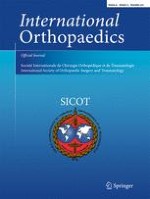Erschienen in:

22.07.2017 | Original Paper
Biomechanical evaluation of distal biceps tendon repair using tension slide technique and knotless fixation technique
verfasst von:
David D. Savin, Hristo Piponov, Jonathan N. Watson, Ari R. Youderian, Farid Amirouche, Giovanni F. Solitro, Mark R. Hutchinson, Benjamin A. Goldberg
Erschienen in:
International Orthopaedics
|
Ausgabe 12/2017
Einloggen, um Zugang zu erhalten
Abstract
Background
Acute distal biceps tendon ruptures are uncommon injuries that often affect young active males, typically resulting from an eccentric load on their dominant extremity. The purpose of this study was to compare pullout strength and tendon gapping in the tension slide technique (TST) versus a knotless fixation technique (KFT).
Methods
Two sets of experiments were performed using cadaveric elbow specimens. In the first experiment, eight elbows from different cadavers were tested to compare TST with a standard locking whipstitch with KFT, four elbows in each group, using a standard locking whipstitch. In the second experiment, 12 elbows were used to study the differences between TST with a standard locking whipstitch with KFT using suture tape reinforced whipstitch (RKFT), using the TST data from the first and second experiment. Each experiment evaluated gapping after cyclic loading and the second experiment also tested the construct to load to failure.
Results
Gapping for KFT with a standard locking whipstitch was 10.64 mm versus 2.69 mm for the TST after 1000 cycles (P = 0.016). A reinforced whipstitch significantly improved the failure to gap on the KFT with no significant difference in gapping when compared to TST after 3000 cycles (P = 0.36). The resultant gapping for TST and KST was 2.08 mm and 2.99 mm (P = 0.91), respectively. Load to failure for TST and KFT were 282 Nm and 328 Nm (P = 0.20), respectively.
Conclusion
Bone-tendon gap resistance of a KFT repair of a torn distal biceps tendon is limited by suture technique. Using a tape reinforced locking whipstitch, the repair is as strong as TST repair.
Levels of Evidence: Basic Science.